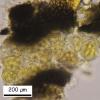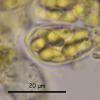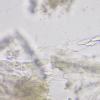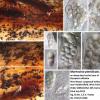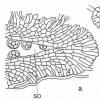
24-12-2025 17:08
Hulda Caroline HolteHello, I have found this propoloid ascomycete on

21-12-2025 09:32
Hello.A tiny ascomycete found embedded in wood in

21-12-2025 21:32
Pol DebaenstHello, Garden, Burgweg 19, Veurne, BelgiumOn 10/1

22-12-2025 23:38
Patrice TANCHAUDBonsoir, récolte sur un mur en pierre, apothéci

22-12-2025 00:47
Patrice TANCHAUDBonsoir, récolte à proximité du milieu dunaire
he encontrado estos hongos creciendo en gramínes muertas y no se por donde buscar. Alguien e puede ayudar?
Ascomas formando surcos de entre 40 y 60 µm de anchos, a modo de laberinto, con dos capas oscuras a los lados, exponiendo el himenio hialino en el centro. Ascas de aproximadamente 15,16 - 20,71 x 10,80 - 12,99, octospóricas, no amiloides. Esporas de (7,01) 7,58 - 8,56 (9,38) x (3,30) 3,40 - 3,72 (3,90) µm; Me = 8,05 x 3,58 µm ; Qe = 2,25, hialinas, con un septo transversal que divide las esporas en dos partes generalmente desiguales, con una gútula de aceite en cada parte (rara vez dos en la parte inferior). No he visto paráfisis.
Saludos.
Salvador.

looks like a Graphidiacea, a lichen.
Regards
Martin
Si que tiene parecido, pero no lo tengo claro, esto es muy pequeño, y por otra parte creo que los líquenes tienen reacción amiloide con IKI (no se si será así con todos) y yo no he visto reacción amiloide. Buscaré bibliografía e estudiaré su propuesta.
Saludos.
Salvador.

I don't have experience in this group. Here is something on it:
http://nhm2.uio.no/botanisk/lav/RLL/GLALIA/GLALIA_1.pdf
Inamyloidity seems to be frequent.
Regards
Martin
Saludos.
Salvador.

Zotto
No me encaja con ningún Graphidaceae, yo pienso que no es un liquen.
Saludos.
Salvador.

Zotto
Saludos.
Salvador.
Saludos.
Salvador.

Saludos.
Salvador.
Hi all,
It could be an Arthonia (s.l.) species, couldn't it ?
Alain

Zotto
Yes you're right Zotto, I read too fast : "y por otra parte creo que los líquenes tienen reacción amiloide con IKI (no se si será así con todos) y yo no he visto reacción amiloide", I don't master Cervantes language :)
Alain
I was giving a look to the keys of lirellate lichens and found only one genus with 1-septate spores: Melaspilea. Some of its characteristics are:
Asci - elongate-clavate, generally thickened at the apex and with a internal apical beak, usully K/I-;
Ascospores - 1-septate, rarely more, ellipsoid to sole-shaped, colourless at first but generally brown at maturity.
There is a species - M. atroides - with clavate, 8 spored asci 22-30 x 11-15 um, with an internal apical beak, sole-shaped spores 8.5-11 x 3.5-5 um. The thallus react K+ orange.
This is the closest species to the dimension you presented. I search the internet for photos without success.
Saludos.
Salvador.
Saludos.
Salvador.

Also in Jones et al. 2009, Marine Ascomycetes FD35
I see a M. mangrovei which is said to be blue in Melzer.
But a test with KOH on the apothecia and area around would be no mistake.
Zotto
Smith at al (Editors), The Lichens of Great Britain and Ireland, The British Lichen Society, 2nd ed. 2009.

Melaspilea mangrovei Vrijmoed, K.D. Hyde & E.B.G. Jones, Mycol. Res. 100(3): 293 (1996)
For Arthoniaceae the book says bluing in iodine, but that is only half of the truth, it requires KOH-pretreatment, otherwise the reaction is red (in Lugol).
Zotto

here is what the abstract says:
Abstract
Melaspilea mangrovei is described from submerged mangrove wood collected in Australia and Hong Kong. The ascomata are superficial, lirelliform, with an opening along the entire length exposing the hymenium. Asci are bitunicate with rostrate dehiscence and the walls stain blue in Melzer's reagent. Ascospores are bicelled, ellipsoidal, hyaline and surrounded by an elaborate mucilaginous sheath. The ampulliform locules of anamorph develop within the ascomata. Conidiophores are hyaline, unbranched and septate, with phialidic conidiogenous cells. Conidia are hyaline, aseptate, smooth, eguttulate and cylindrical. The taxon is presently best placed in Melaspilea, although this genus is badly in need of taxonomic revision.
Regards
Martin

I have sent Salvador's pics to Paul Diederich hoping he can comment on the fungus. The substrate on a grass is unusual for a lichen but not impossible. Whether there is any thallus around is unclear to me.
Zotto
Hola a todos.
Hoy he probado tratando con KOH antes del IKI y debo de deciros que creo que sí que las ascas reaccionan coloreándose de azul levemente (tendría que haber probado esto antes). Hoy he tenido más suerte y he cogido algunas ascas en posición lateral, y también les he puesto Melzer después y se aprecia mejor el ápice de las ascas. Yo no veo talo por ninguna parte, los ascomas crecen directamente sobre la gramínea.
Las ascas y las esporas parece que podrían encajar más o menos con Melaspilea atroides como dice Zacarias, aunque yo no he visto ninguna reacción naranja con KOH, además me gustaría saber la descripción de los ascomas, ya que por ejemplo M. mangrovei tiene ascomas de 2,5 mm de largos y 0,5 mm de anchos y este hongo es mucho menor, hasta de 0,5 mm de largo y entre 0,04 y 0,06 mm de ancho. No se ve a simple vista, yo lo vi por que estaban junto a Parachnopeziza alaunae y mirando con la lupa unas muestras de esta los vi cerca.
Pongo unas fotos.
Salvador.

Amitiés
Chris

you made a fine series of photos. But you made one mistake: as you say your Imagen3-0005.jpg shows a slight blue and I also think it is an iodine reaction. Since the iodine itself is invisible (no yellow stain to the plasma), your Lugol (I2) reacted with KOH by forming colourless KI, and the blue might be much stronger if you had added more Lugol (or better wash with water). Imagen4-0010.jpg shows very fine the apical thickening, but in Melzer the hemiamyloid reaction is suppressed, and your KOH+IKI series is again without presence of yellow I2.
Very nice this Parachnopeziza in association!
Zotto
No había considerado Morenoina (no lo conocía) pero seguro que sí es, lo veo muy similar, aunque no tengo nada de bibliografía sobre el género y no sé como determinarla. Si tiene usted algunas claves para el género, o alguna bibliografía le agadecería si me lo puede enviar.
Muchas gracias.
Salvador.
Saludos.
Salvador.
Thallus evanescent, whit to cream or yellow-tinged near the apothecia. Apothecia 0.2-2 x 0.1-0.2 mm, oblong to ellipsoid, sometimes branched or curved, disc slit-like; true exciple inflexed and raised, 24-31 mm; hymenyum with brownish pigmented bands, I+ blue; hypothecium dark-brown; paraphyses anastomosing, the apices with brown granules.

a short description of this genus and two taxa is given in Müller and Arx, which I did send to you (ask me in case to help with the German text).
And attached a plate by Scheuer of Morenoina festucae. (Festuca beeing a Poacea).
A promising hint Chris!
Regards
Martin

Chris
Con las claves de Ellis me encaja a la perfección con Morenoina festucae. Las esporas de mi colección son lisas y con gútulas por ser inmaduras, (parece ser que cuando maduran son finamente verrucosas y pierden las gútulas) cosa que también aparece en el dibujo de Scheuer. Pero en ninguna de las descripciones del género dicen nada de los tonos azulados que he visto con IKI tratando la muestra antes con KOH. Hoy probaré a lavar la muestra mejor con agua como me comenta Zotto para ver si los tonos azulados aumentan.
Tengo otra consulta respecto a la amiloidad en Hysterostegiella, pero esto lo haré cuando tenga algo de más tiempo.
Saludos.
Salvador.

I read in Fungal Families that the Asterinaceae have a hymenium bluing in iodine, but the genus Morenoina is not mentioned.
Amyloidity is frequently overlooked in such hemiamyloid taxa when they are not lichenized because workers on non-lichenized fungi traditionally used Melzer contrary to lichenologists. I guess this is the reason why we read nothing in Pamela Ellis.
Zotto

Cannon published a Morenoina from Pakistan (attached). He states that the whole ascus wall is staining pale blue in iodine.
Regards
Martin

nice fungus. Ralph Vandiest has found a similar species, still unknown. I now think it is also Asterinaceae, but I have to look for a species...
http://ascofrance.com/forum?page=5
regards,
björn

Zotto
Gracias por el artículo Morenoina from Pakistan Martin.
Saludos.
Salvador.
 Imagen4-0009.jpg
Imagen4-0009.jpg